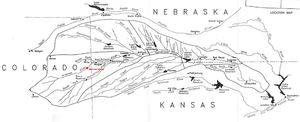Battle of Beecher Island
| Battle of Beecher Island | |||||||
|---|---|---|---|---|---|---|---|
| Part of the Comanche War, American Indian Wars | |||||||
 A map of the Republican River and its tributaries, with the location of Beecher Island highlighted in red. |
|||||||
|
|||||||
| Belligerents | |||||||
|
|
Arapaho Cheyenne Sioux |
||||||
| Commanders and leaders | |||||||
|
|
Roman Nose† | ||||||
| Strength | |||||||
| 50 cavalry | 200-1,000 warriors | ||||||
| Casualties and losses | |||||||
| 6 killed 15 wounded |
9–32 killed | ||||||
|
|
|||||||
The Battle of Beecher Island, also known as the Battle of Arikaree Fork, was an armed conflict between elements of the United States Army and several of the Plains Native American tribes in September 1868. Beecher Island, on the Arikaree River, then known as part of the North Fork of the Republican River, near present-day Wray, Colorado, was named afterwards for Lieutenant Fredrick H. Beecher, an army officer killed during the battle.
In the summer and fall of 1868, continuing their annual seasonal raiding activities between the Arkansas and Platte Rivers in what was also the region of their best buffalo hunting, bands of Cheyenne and Arapaho Indians conducted raids against whites throughout the western Great Plains in Kansas. In addition, they found incentive in the warfare that had been waged specifically against their clans by the military in 1867, and by memories of such atrocities as the Sand Creek massacre. Finally, the westward movement of the transcontinental railroad had stretched all the way across Kansas, bringing with it many permanent white settlements
During the 1867–1868, the Cheyennes were in schism, with those advocating peace (possibly a majority) retreating south out of Kansas, and the younger, intractable warrior societies continuing to raid. The latter during the summer of 1867 had successfully avoided a large expedition commanded by Maj. Gen. Winfield S. Hancock, and in the process had garnered sympathy from Americans in the East who supported peaceful negotiations after Hancock attempted to bully the Cheyennes to submit, and burned their abandoned villages when they did not.
In August 1868, General Philip Sheridan, replaced Hancock in command of the Department of the Missouri, was asked by acting Governor Frank Hall of Colorado for assistance after 79 settlers were killed in repeated attacks on farms, ranches, way stations, and travel routes. Sheridan's main effort was to be made south of the Arkansas, a winter campaign in the Indian Territory, but he remained active in Kansas during the warmer weather, patrolling the Arkansas with the 7th Cavalry, and the area between the Republican and Smoky Hill Rivers using the 10th Cavalry.
...
Wikipedia

